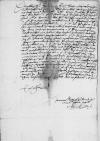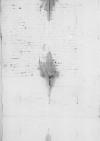Letter #5234
Ioannes DANTISCUS to Albrecht I von Hohenzollern-AnsbachHeilsberg (Lidzbark Warmiński), 1540-02-15
| received Königsberg (Królewiec), 1540-02-17 Manuscript sources:
Auxiliary sources:
Prints:
| ||||||||||
Text & apparatus & commentary Plain text Text & commentary Text & apparatus
 GStA PK, HBA, C1 No 631 3 unnumbered
GStA PK, HBA, C1 No 631 3 unnumbered
Dem durchlauchten, hochgebornen fursten und herren, hern
 GStA PK, HBA, C1 No 631 1 unnumbered
GStA PK, HBA, C1 No 631 1 unnumbered
Durchlauchter(r) herr text damaged⌈[r]r text damaged⌉ [...] text damaged⌈[...][...] text damaged⌉ text damaged⌈[] text damaged⌉ner(r) furst, / hohgunstiger(r) und vilgeliebter(r) herr(r) und freundt text damaged⌈[undt]undt text damaged⌉. / Mein freuntliche und gancz fleisgewilgete(!) dienst zuvoran(n). /
Den edlen(n), ernfesth(en) h(ern)
[...] stain⌈[...][...] stain⌉
E(wer) F(urstlichen) D(urchlauch)t willig(e)r



